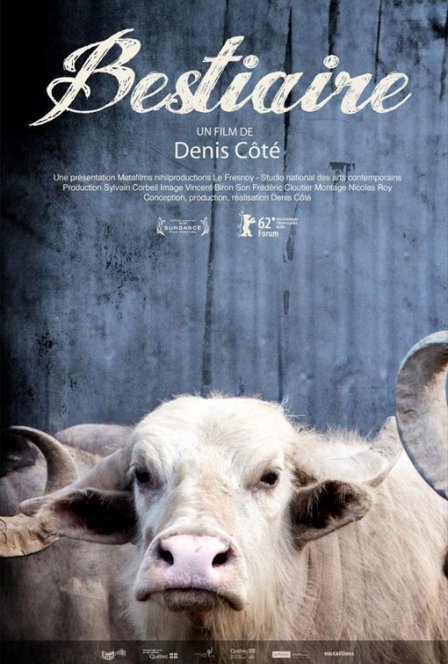Writing is to language as taxidermy is to a duck.
Bestiaire is an astonishing ethnographic study of a prison. With neither soundtrack nor narration, its 122 static shots — lasting on average slightly more than 33.5 seconds — frame the lives and unreal afterlives of some animals.
This is one of the most distressing films I’ve ever seen. I’ve been losing my mind over the last several days since first watching it.
Bestiaire opens with close-ups of the faces of five arts students as they draw. Medium shots as they draw a deer. A long shot as they draw a deer while looking at a taxidermic deer under artificial lighting.
This is one of the best essays into epistemology I’ve ever witnessed. Alfred North Whitehead’s ghost is in the machine.
Wikipedia defines analysis as “the process of breaking a complex topic or substance into smaller parts to gain a better understanding of it.” Analysis cuts into the real and removes an image of a moment, which it will play with until the process of analysis has issued objects that can be assembled into a reproduction of the situation of the original cut. The product of an analysis is always an abstraction of a model of a simplification. It is always a taxidermic duck.
Bestiaire is not a drawing of a mummified corpse. It begins with the art students in order to introduce the necessity of mediation and immediately overcome the limitations of a medium that doesn’t move. This is either extraordinarily difficult or quite easy to say. In order to see anything, a sighted organism has to continuously, assiduously look differently. Vision operates the same way cinema operates, which is to say by sequencing images in time and synthesizing their movement. If you could pin your eyeballs so that they didn’t shudder, your field of vision would go blank.
From the art students we move to Parc Safari, an enormous zoo amusement park in Hemmingford, Québec. It is winter. Many large animals, most from Africa and Asia, survive somehow through the Québécois winter. It becomes impossible to deny that the lives we witness are characterized by frustration, anxiety, terror, and boredom. A guanaco paces back and forth along a fence, gazing through it at an imagined way out, perhaps, if not a way home. Two zebras suffer anxiety attacks in their shockingly cramped stall as an employee makes loud noises while cleaning the facility. A lion and lioness bash at the doors of their cells. An enormous, beautiful bird with one wing pecks nervously at the wood frame of a mirror propped against the wall.
I have hardly enough room here to discuss even a fraction of the movements that deserve, if not demand, attention. I recommend to whoever attempts to write seriously about this film — a time will come when many will have written about it — that s/he compare Mark Tansey’s 1981 painting The Innocent Eye Test.
The only fade-out. The first shot in the taxidermy workshop is of a spinning bin and, on the wall beyond it, two pin-up girls in bikinis, the paper faded to sepia. Pin-up girls. Three men prepare a duck for display. Skulls, antlers, heads, and bodies line the walls. Tagged, sorted… analyzed.
Parc employees attend to the animals outside in better weather. Three house cats dine on raw meat. (Which animal did it formerly belong to in living motion?) Three bears sit back on their haunches and catch in their mouths morsels thrown from a bucket. Even the ones whose children can’t be reduced to house pets can themselves be reduced to dependency. They move when their wardens want them to; they eat when their wardens allow them to.
Then the visitors arrive. A girl dons a costume to become one of the Parc’s Filouminous, five dubiously feline fun mongers who share a DGAF fashion sensibility and distressed jowls. It bears repeating: there are humans dressed as cartoonish, clothed bear-cats roaming a park that owns hundred of animals who would otherwise be living thousands of miles away. The Parc boasts a petting zoo, elephant rides, carnival games and rides, and a gridlocked drive-thru section where animals can risk being hit by impatient motorists.
The rush of a plane high overhead and the far-off chord from a train make ominous music. I haven’t ever been to Parc Safari, but my guess is that it hosts a slew of distractions because it might get uncomfortable to watch half lives. How entertaining would it be to tour a penitentiary?
Bestiaire isn’t entertaining. It opens up space for reflection on what’s under the noses of lovebirds and kids and all the rest. If you find yourself bored watching Bestiaire, it’s because you’re a bad person. No, but it takes discipline not to think that way. If you find yourself bored watching Bestiaire, it’s because you don’t want to think about what you’re looking at. You don’t want to see what makes it possible for you to ignore the animals when lured to Parc Safari for the attractions.
If the Devil is God’s ape, are we then the insects in their hair? Parc Safari has surpassed Disney Land as the paragon of hyperreality. Bestiaire is the threshold or the lintel of a proverbial door opening out into a way of seeing. It’s the banks of a stream of consciousness.
The closing credits play over the sounds of the art students’ pencils.
“Guided by a passionate team, Parc Safari is striving to become ever more beautiful and complete for you, our guests.” How would a compassionate team guide Parc Safari? What would the rest of the world look like if Parc Safari were complete?
Bestiaire makes no claims. But that which it depicts makes claims on us. Who in Québec will read this?

